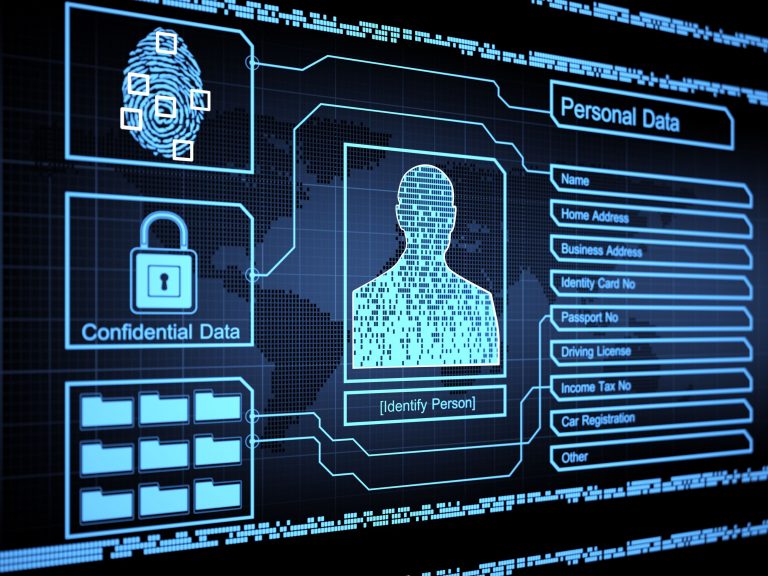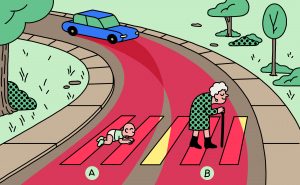

Self-driving cars have always been a dream for humanity. Lots of movies, cartoons and books included autonomous vehicles like Batmobile to Wonka’s flying elevator, though it was not a car, it sure was an autonomous vehicle. Even though it is tempting to have a car that drives itself so that you can attend other things like doing your make up on the road, reading the news or having breakfast. No one is actually thinking about the possible risks and vulnerabilities it might create. The car won’t have extreme actions like going crazy to protect you like the episode in Rick and Morty where the ship killed people to protect Summer. However, there are some issues that we need to be aware of so that the technology we created to have more comfort, will not cause problems on the way.
Data Privacy

It’s not without reason that everything has its costs. This also applies to the comfort and safety benefits that autonomous cars bring with them. However, in this case, you don’t just pay with your money. The technical possibilities to adjust the driving experience to you as an individual and take over tasks are often paid for with your privacy by disclosing your data. The car will have to collect personal data for authorization purposes. As you adjust your comfort, safety, and entertainment settings, information about you as a driver is collected continuously, making it theoretically possible to identify you accurately. Further, location tracking is a necessity in autonomous vehicles. Centralized navigation systems offer many beneficial features, such as avoiding traffic jams or toll roads or decreasing pollution by providing eco routes. However, location data collection is becoming increasingly comprehensive and personalized. For example, modern navigation systems remember locations that you frequently visited and save them as home or favourite locations. One might say now, what do I care? I don’t have anything to hide. And indeed, at first glance, sharing all of this information seems to be associated primarily with personal benefits. However, the combination of all data units based on your public movements and customized settings enables the creation of a precise, comprehensive profile including details about your familial, political, professional, religious, and sexual associations. Of course, service providers usually commit to protecting drivers’ privacy. However, privacy abuse has occurred in the past, both intentionally and accidentally. One example is the Waze privacy attack. Customers could see the current traffic in a selected window. By moving the window, the live location of individuals could be tracked. To prevent such privacy attacks, mechanisms have been developed that aim to secure the privacy of car owners. One example is the Differential privacy mechanism, which assures that the data of a person can be used without the data owner being listed in the database. In this way, the anonymity of the owner is preserved.
Car Hacking

Already in 2016, there were official warnings from the Federal Bureau of Investigation and National High Way Traffic Safety about the increasing vulnerability of cars to remote exploits. As autonomous vehicles become more connected to the outside world, they become more vulnerable to cyberattacks that could result in engine shutdowns, disabled brakes, or locked doors, seriously endangering the safety of the occupants of the attacked cars as well as the surrounding cars. With features such as Bluetooth, infotainment, remote monitoring, and cellular connections, linking the car to the outside world, the attack surface grows, increasing the vulnerability of the car. In July 2015, two researchers, Charlie Miller and Chris Valasek, managed to hack into a Cherokee Jeep while someone drove it on the highway, 10 miles away. They were able to remotely control the vehicle’s functions over a simple 3G connection by finding a vulnerability in the Uconnect software. They sent commands over the in-vehicle network and were able to kill the engine, disable the brakes, take control of the steering wheel, and eventually send the vehicle into the ditch. This cyber carjacking incident led to the recall of 1.4 million vehicles. Other scientists demonstrated that nearly 100 million Volkswagen vehicles that were sold between 1995 and 2016 are vulnerable to remote key entry hacks. The attacker can clone a Volkswagen remote key and gain unauthorized access to the vehicle by detecting a single signal sent by the original remote. These are just a few of many examples in which it has been shown that physical access is no longer needed to take control of someone else’s car. Via wifi and Bluetooth, it is sufficient to be within the communication range of the target vehicle to obtain important information or to take control of functions. The Uconnect software hack demonstrates that cyber attacks can be executed from miles away. By distracting the driver, apparently innocent attacks of the loudspeakers or windshield wipers can be enough to cause serious accidents and claim lives by distracting the driver. Many mechanisms, such as OTA (Over-the-air) updates or cloud-based solutions have been developed to protect autonomous cars from harmful attacks. However, it is important to keep the development of protection mechanisms at the same pace that cars are gaining connectivity through innovation.
Ethical Issues: More than Trolley Problem
When it comes to the ethical issues related to autonomous vehicles, they are more than the trolley problem. The trolley problem is an ethical dilemma where the person needs to decide whether to divert the trolley or not in order to save 5 people that trolley was about to kill rather than 1 person. This dilemma might seem basic enough but it might go in multiple directions. For example, if the car is in a situation where there is an elderly person and a young one that are in danger and only one of them can be saved. What will happen then? Everyone has an answer in mind but the problem is that your answer might not be acceptable to everyone. In a study conducted with people from 130 different countries, they have found 3 different moral groups. First one contains Christian – European countries, second one is Islamic – Asian countries and the third one South America and French colonies. It turned out that the first group demonstrated a stronger preference to sacrifice the older to save the young compared to the second group. It is unclear how companies and governments would handle such problems but one solution would be to regulate their own rules instead of universal ones. However, there are more issues to discuss such as which one to favor in case of accident passengers or pedestrians, would a car be able to distinguish a pregnant lady, what if people start to deceive in order to give themselves a higher protection priority? A survey done with 2.3 million people around the world found out that people are agreeing to sacrifice passengers to protect pedestrians. However, they also agree on not buying such an autonomous vehicle. People want environmentally and socially considerate self-driving cars, but they also want software to prioritize saving them. It will create some problems such as unequal market competition. Imagine two competing companies that have 80% of eliminating accident success. One that has 7/9 that favors passengers and the other has 50 to 50 rates between passengers and pedestrians. Consumers would choose the first company over the second one. After a while, the second company would have no choice than to change their policy to increase their sales. It might not create such nuance in statistics at first but imagine adding up those small statistical differences. Those would add up causing death and life consequences.

Economic Problems: Drivers to Nurses
Let’s assume the other problems are solved and self-driving vehicles have become the ultimate transportation. Sounds quite good, people will save a lot of time and energy and can use the time for other things like napping on the road, completing work and so on. What would happen to drivers? A statistical calculation estimated that 5 million jobs in the U.S. alone will be over which is around 3% of the workforce currently. In the Netherlands, this number is 600 thousand people that are working in the transport sector such as taxi, truck or other kinds of driving. This might not sound like such a significant number compared to the U.S., however, the total loss of income could be 14 billion euros in a year. This will not end with drivers losing their jobs, also any job that is related to the automation industry will be affected such as car washers, auto engineers or car dealers. The more complex level of this problem is that people who are working in those jobs are usually people without college degrees. Self-driving cars will benefit already big companies like Google, Uber, Tesla, but will cost lots of Uber, taxi and other types of driver’s jobs. Already, computer scientists, software developers earn a lot of money because the software of such technology is too expensive. Only very wealthy people would afford to use such cars and the remaining half already has troubles with using private transportation. Thus, these issues will increase the economic gap in the society. It is unrealistic to expect everyone in society to have a college degree and such jobs. Even those might be affected like hospitals. Every year around 2 million visits to hospitals are caused by traffic accidents. Thus, these issues will increase the economic gap in the society. It is unrealistic to expect everyone in society to have a college degree and such jobs. Even those might be affected like hospitals. Every year around 2 million visits to hospitals are caused by traffic accidents. If there will be fewer accidents thanks to self-driving cars, the health sector would be affected by that due to a reduction in hospital visits. McKinsey and Company estimated that consumers of self-driving cars will save around 180 billion dollars from health care and auto repair bills. Although that sounds promising and positive from a consumer side, it also means many losses for service providers. We should ask this question to ourselves before making progress on autonomous vehicles; Is it fair to kill such an industry and leave many people jobless and broke? Governments should find a way to regulate that problem if humanity will use self-driving cars only in the future around the corner.
Why do we want autonomous cars?
Despite the risks and vulnerabilities, autonomous traffic will offer many opportunities. There are some advantages of autonomous vehicles other than giving us free time on the roads. The earth is suffering from global warming. Autonomous vehicle technology might reduce energy use and decrease emissions by 90%. Not just the usage of energy, but also the traffic jams will decrease. Since self-driving cars will use live GPS, it will not only increase safety but also reduce driving time and decrease possible traffic jams. The new systems developed for autonomous vehicles will minimize human errors by having hill descent control, intelligent speed adaptation and automatic braking. The World Health Organization (WHO) announced that 1.35 million people died in 2016 due to traffic accidents worldwide. Autonomous cars can build a safer world for humans. However, the transition period from human drivers to autonomous cars might even cause more traffic accidents than ever. In 2018, the first fatal accident of an autonomous car occurred. One of Uber’s self-driving cars caused the death of a woman in Arizona. This might be the beginning of many accidents if we won’t be careful.
What to do next?
Just as smartphones have evolved from luxury items to average phones over the past decade, widespread autonomous transport will be a reality on the roads in the near future, whether we wish for it or not. That is why it is important to clarify important issues for risk prevention now, while we are still in the transition phase. Ethical issues need to be discussed and solved in order to find uniform and fair solutions. Inevitable mass loss of jobs and resulting increasing gap in society must be prevented by creating alternatives beforehand. In addition, security mechanisms that protect against privacy abuses and hacker attacks must be developed in parallel with the development of autonomous software, not afterwards. Autonomous driving is an exciting innovation that offers many opportunities that we can benefit from. However, the risks and vulnerabilites must be discussed as early as possible. History proves that a society can cope with many big changes. Now we still have the opportunity to anticipate the change and use the preparation time to minimize negative consequences in the future.


